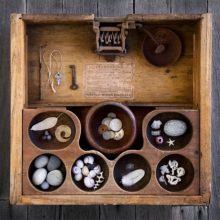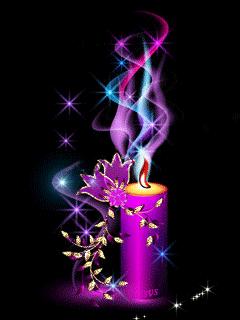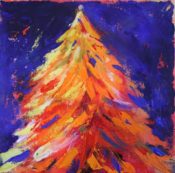Throwing The Bones
In bone divination, bones of various sorts are ritually tossed onto a mat, an animal hide, or into a circle drawn in the dirt, and the resulting patterns interpreted.
Throwing the bones is an ancient practice traditional to many regions of the world, including Africa, Asia, and North America. The number and type of bones employed, as well as the inclusion of other small objects, such as pebbles, shells, and hard nuts, varies quite a bit from culture to culture.
In the traditions of some cultures, the bones, shells, and/or nuts that are to be thrown are left in their natural state; in other cultures they may be shaped and marked, much like dice, dominoes, or the cut cowrie shells used in Obi and Diloggun divination.
Marked bones are often used in groups of two or four to obtain yes or no answers, as well as more detailed information. There is quite a bit of evidence to support the idea that gaming dice, often casually called “the bones,” may have had their origin in marked bone divination, as there are still forms of divination in which the markings of the spots and dots on dice or dominoes are used to read fortunes for clients.
As a hoodoo practice, casting or throwing the bones has deep traditional roots in African culture, especially as developed among the sangomas or divining healers of the Zulu, Swazi, Xhosa, and Ndebele traditions in southern Africa. Trained as herbalists, spirit mediums, and diviners, they fulfill an important role in their culture, equivalent to that of a root doctor in the United States or an obeah practitioner in Jamaica.
Mingling of African traditions with Native American and European forms of divination have produced quite a lot of variation in hoodoo practices. Traditional items used by Southern-style hoodoo doctors and spirit-led fortune tellers who employ these ancient methods of divination include bones, stones, coins, stalks, or shells. Additionally, some who follow this style of divining with natural curios may also perform augury by inspection of natural botanical and zoological curios such as owl pellets.
According to Catherine Yronwode, a well known author and practitioner in the world of Hoodoo, there are three basic forms of bone divination:
- Heated and cracked bone reading:
a form of Pyromancy. Usually done by heating the shell of a turtle, ox scapulae, or turtle plastrons in fire and then interpreting the cracks that form. This began and was primarily practiced in ancient China, in the late Shang Dynasty. - Mathematical systems of bone reading:
Geomancy. An example of this is Hakata, a very interesting form of divination found in Africa, where one would interpret hand-made tablets by the markings inscribed there on. - Spirit-led interpretive bone reading:
Cleromancy. This is a Shamanic from of divination. It is used, and varies greatly, among many different cultures and beliefs. A wide array of animal bones are used in Shamanic bone reading. The bones carry different meanings and energies according to what animal they belonged to, and what type of bone it is (tooth, claw, hand bone, etc.)
 Although there is no single system of bone or curio divination used by all African American practitioners, some old-timers read a set of chicken bones or ‘possum bones, and do so only on the ground rather than a table-top, after the manner still practiced in Africa to this day. Others mix pebbles with their bones, as some sangomas do, and might read on a table-top — but no matter what natural curios are included, the practice is still called “throwing the bones.”
Although there is no single system of bone or curio divination used by all African American practitioners, some old-timers read a set of chicken bones or ‘possum bones, and do so only on the ground rather than a table-top, after the manner still practiced in Africa to this day. Others mix pebbles with their bones, as some sangomas do, and might read on a table-top — but no matter what natural curios are included, the practice is still called “throwing the bones.”
Hoodoo bone readers consider it traditional to keep their divination bones in a basket, bowl, or bag on or near their altar when not in use and to cast them out onto a mat, a hide, or a circle to read them, which are African techniques of working. Each bone may have a meaning, and the patterns among the bones may be significant as well.
For example, in one family tradition, nine chicken bones are used, and each bone has a meaning:
- wing bone signifies travel
- neck bone signifies poverty
- wish bone signifies good fortune
In addition to being used in rites of throwing, bones are also ritually manipulated in other ways for the purpose of telling the future for a client. For instance, they may be burned in a fire and the resulting chars and cracks examined in order to determine specific answers.
Bones, as well as other body parts, may also be used as a means to communicate mediumistically with the dead and with spirits, through psychometry.
Many diviners believe that one’s set of bones should be special and unique to the individual. You simply cannot go out and buy a bone divination set. Bones can be gathered, bought, obtained from different sources, but the completion of the set and power lay with the the individual’s personal contributions.
Practitioners of Hoodoo will use a wide array of bones along with artifacts or game pieces to represent a specific person. The Sangomas, an African people who greatly influence the Hoodoo tradition, believe that it is their ancestors speaking through the bones; so to aid in communication, will carry a porcelain doll head containing dirt from the grave site of the ancestral spirit they work with.
Among the Mongolians, four unmarked sheep knuckle bones are thrown, each of which has four distinguishable sides, which produces an array of 36 possible answers to any given question. The name for this system of divination is shagai, often rendered in English as “Complicated Fortune Telling.” In addition to functioning as a system of divination, shagai can also be played as a gambling game.
Source: Readers and Rootworkers and Mama Bee’s Blog
Debbie: Reading Candle Wax
Bridget Grimes: 310112_svyatki2_500
Mari: Reading Candle Wax
Ali: Notarikon
ALI: Notarikon




Leave a Reply